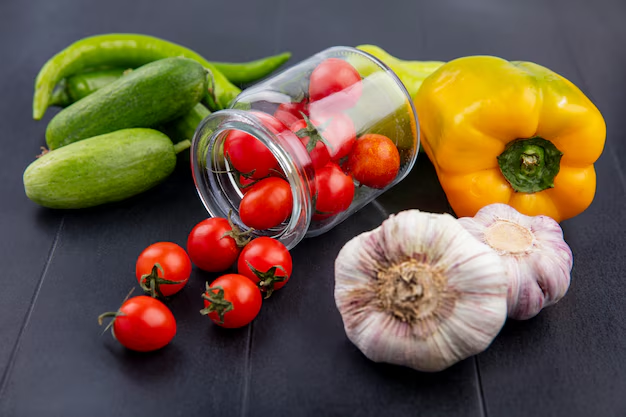The Ultimate Guide to Storing Vegetables in Your Refrigerator 🥦
Imagine this: you just visited the farmer's market, your bags bursting with the fresh bounty of the season. But just a few days later, your spinach is wilting and your carrots are limp. Storing vegetables properly in your refrigerator is an art that ensures longer shelf life and peak freshness. Let's delve into how you can optimize your fridge's environment to keep your veggies crisp, colorful, and delicious for as long as possible.
Why Proper Storage Matters
Many vegetables naturally release ethylene gas as they ripen, which can cause nearby produce to spoil faster. By strategically storing your vegetables, you can reduce waste, save money, and enjoy tastier meals. Understanding the basic mechanisms of food spoilage and how refrigeration plays a role provides a solid foundation for better food storage practices.
The Fundamentals of Refrigerator Storage 🥬
Temperature Settings
The ideal refrigerator temperature for vegetables is between 32°F and 40°F. This range helps slow down the activity of bacteria and enzymes while maintaining the vegetables' texture. Keep your refrigerator's thermostat steady and avoid overloading; good air circulation is crucial for even cooling.
The Crisper Drawers
Most refrigerators come with crisper drawers designed for produce. These provide a more humid environment, ideal for leafy greens and vegetables that thrive in such conditions. Remember to set these drawers correctly—many have adjustable vents to control humidity levels. A high-humidity setting works for most vegetables, preventing them from drying out.
Ethylene-Sensitive Veggies
Some vegetables are sensitive to ethylene gas, which accelerates spoiling. Here's a table of common veggies and their ethylene sensitivity:
| Vegetable | Ethylene Sensitivity |
|---|---|
| Leafy Greens | High |
| Cucumbers | High |
| Carrots | Low |
| Onions | Medium |
| Peppers | Medium |
Best Practices for Storing Common Vegetables
Leafy Greens
Loose Leaf Lettuce, Spinach, Kale:
- Storage Tip: Wash and thoroughly dry before storage.
- Use: High-humidity crisper drawer.
- Additional Tip: Place a paper towel in the storage bag to absorb excess moisture and keep greens crisp.
Root Vegetables
Carrots, Beets, Radishes:
- Storage Tip: Cut off the greens if present, as they draw moisture away from the root.
- Use: Store in a perforated plastic bag in the crisper.
- Additional Tip: Avoid storing near apples or pears, which emit ethylene gas.
Cruciferous Vegetables
Broccoli, Cauliflower, Brussels Sprouts:
- Storage Tip: Keep them in perforated bags to allow air circulation.
- Use: Preferred in the refrigerator's main compartment.
- Additional Tip: If you wash them first, ensure they are completely dry to prevent mold growth.
Fruits That Double as Vegetables
Tomatoes (often classified with vegetables in storage terms):
- Storage Tip: Best stored at room temperature until fully ripe, then transfer to the refrigerator to extend shelf life.
- Use: Keep them in a separate space to avoid flavor absorption by other vegetables.
- Additional Tip: Remove as needed and let them reach room temperature before consuming for the best flavor.
Avoid Common Mistakes 🚫
- Storing all vegetables together: Mixing ethylene-producing and ethylene-sensitive vegetables accelerates spoilage.
- Overloading your fridge: A cramped refrigerator has poor airflow, leading to uneven temperatures and quicker deterioration.
- Improper use of plastic bags: Use breathable storage bags for most vegetables, as tight plastics can trap moisture and accelerate spoilage.
Planning and Organizing Your Fridge Layout 🗺️
Separate by Shelves and Drawers
- Top Shelf: Best for items that require stable, colder temperatures like fresh herbs in water.
- Middle Shelf: Home for vegetables that are less sensitive to temperature fluctuations, e.g., peppers and zucchini.
- Crisper Drawers: Reserve the most delicate produce like leafy greens and herbs.
Utilize Containers Wisely
Consider transparent, shallow containers for easier visibility. Stackable containers maximize space but ensure they aren’t packed tight to allow circulation.
Extending the Shelf-Life Further 🧃
Freezing Overripe Vegetables
When your vegetables reach their peak or beyond, freezing them can be a great option. Most vegetables freeze well if blanched first, which helps preserve color and flavor. For instance, blanch carrots for three minutes before popping them in the freezer.
Pickling for Preservation
Beyond refrigeration, pickling is an age-old method for extending the shelf life of vegetables like cucumbers and radishes. This not only preserves them but also adds a tangy flavor profile to your meals.
A Quick Summary Checklist 📝
To make your life easier, here's a quick, skimmable checklist for optimal vegetable storage:
- 🧊 Check Temperature: Ensure your fridge is set between 32°F and 40°F.
- 🥬 Humidity Matters: Use the high-humidity setting for leafy greens.
- 🚫 Avoid Mixing: Keep ethylene-sensitive items away from ethylene producers.
- 📦 Use the Right Bag: Choose perforated plastic bags for better air circulation.
- 🗂️ Organize Smartly: Keep your fridge uncluttered for better airflow.
- 🍅 Room Temperature First: Let ripening items, like tomatoes, sit out before cooling.
- ❄️ Consider Freezing: For long-term storage, blanch and freeze surplus veggies.
- 🥒 Pickle for Flavor: Transform excess vegetables into delicious pickles.
By implementing these best practices and insights, you're setting the stage for a refrigerator full of vibrant, fresh, and long-lasting vegetables. Keep your kitchen stocked with the best the season has to offer, while ensuring you minimize waste and maximize flavor. After all, the way to a delicious vegetable-filled meal starts with how you store them!
